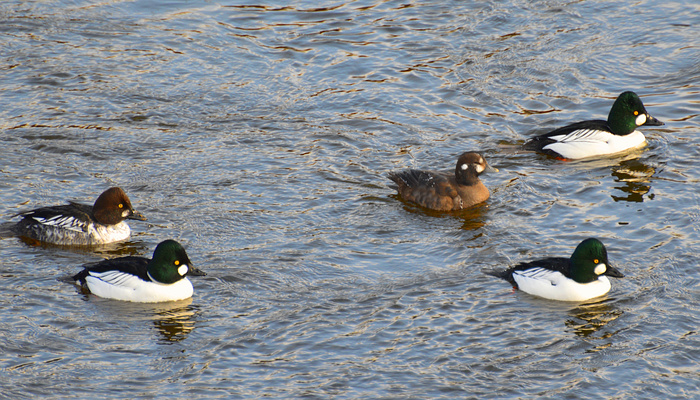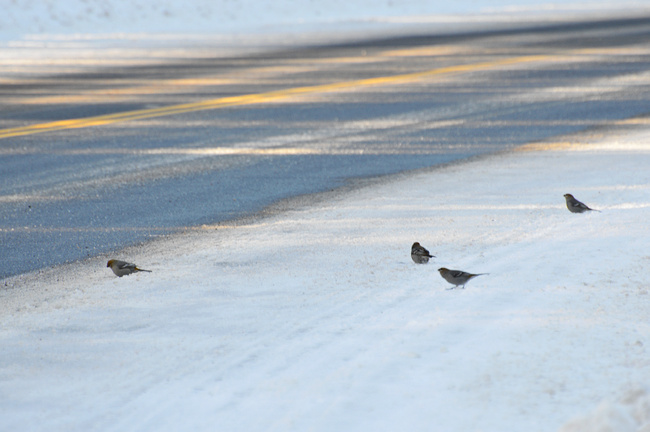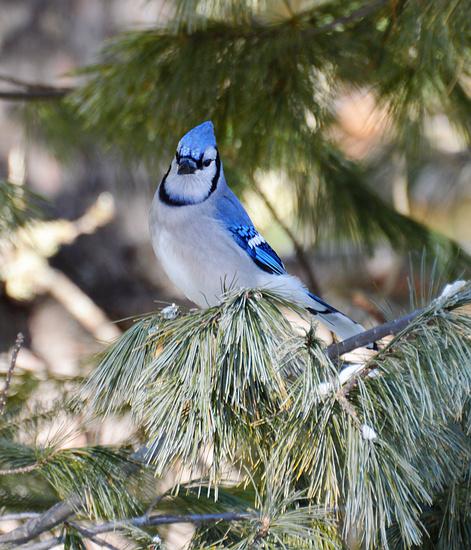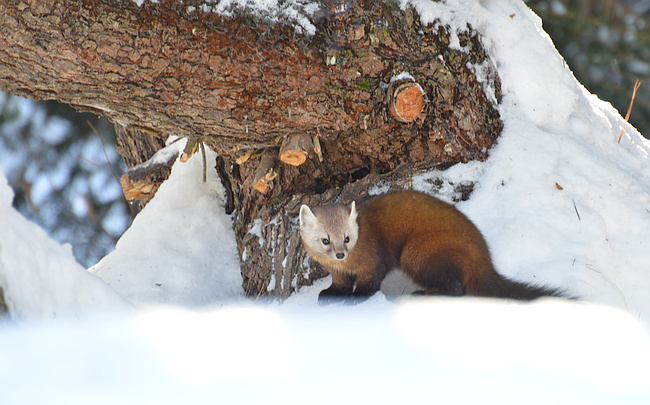
Tiding Us Over
March 30th, 2017
In mid-May, Michael is joining me for a four-day bird-watching trip to Point Pelee, led by birding dynamo Jon Ruddy. This will be my third time in Point Pelee at the height of spring migration, and I'm thrilled to be going back. Hopefully, for the first time, I can get good photos of the warbler extravaganza. (The first time I got some photos, but mostly not of warblers. The second time my back gave out and I had to stow the camera away. This time, I'm planning to buy a camera harness to help with the back issues.)
In the meantime, here are a few recent and not-so-recent photos. This first one is the last of my summer 2016 backlog. I call it "Reaching For The Sun", which is rather what I'm doing around now in Ottawa!

1680x1050 wallpaper

This young male Harlequin Duck (the brown one in the middle) spent the winter on the Rideau River, often near Hurdman Bridge. On this day in mid-January he was keeping close company with a group of young male (the leftmost duck) and adult male Common Goldeneyes. The large majority of Harlequins live in the west, breeding on turbulent mountain streams in places like Banff. The Atlantic population, which is presumably where this one strayed in from, is small and endangered.
The adult male Harlequin is spectacularly handsome; unfortunately we seldom see one of those here in Ottawa. However, we might if this guy sticks around long enough! I saw him again just today, and while he wasn't showing much color yet, the markings on his face were a lot more well-defined and striking.

1680x1050 wallpaper
It saddens me that birders snub so many interesting birds because they're common, or non-native, or otherwise uncool. I've made it my mission to keep seeing the beauty in what some call "dirt birds." Today's exhibit: a resplendent Rock Pigeon, sharing birdseed with another pigeon and a Red Squirrel along the Rideau River.

Photographed just a few days ago, goldfinches at my kitchen balcony feeder. These two males are molting out of their drab winter plumage and into their dazzling yellow summer plumage. The one on the left was further along in his molt and looking very pretty, I think!
Winter in Algonquin: Visitor Centre and Opeongo Road
February 7th, 2017
At the Visitor Centre I had some welcome hot food, then headed to the viewing platform to check out the famous feeders. They usually have a flock of Evening Grosbeaks in winter, but on this afternoon it was goldfinches, plus the odd redpoll and siskin.

1680x1050 wallpaper
I enjoyed the sight of goldfinches crowding into the surrounding trees waiting their turns.

Another interesting but very distant (too distant for pictures) sight from the platform was a moose carcass being fed on by a red fox. The moose had been road-killed, and park staff put it out in the valley for the benefit of scavengers. So far a fisher, a marten, the fox, ravens, wolves, and a Bald Eagle have all been seen at the carcass! The scavenger-fest (if it's still on by the time I post this) can be viewed on live webcam at the Algonquin Park website.
After lunch we headed to Opeongo Road, where, at the junction where the road is gated off, we were met by another friendly, hungry group of Gray Jays. This time I decided to photograph the action. I found this kind of photography very rewarding--capturing the joy on peoples' faces as birds alight on their hand with complete trust.

That's "WOSLROWR" (white over standard left, red over white right), the just one-year-old territorial female of Cameron Lake Road.

Her six-year old mate.

1680x1050 wallpaper
"GOBLBOSR" (green over blue left, blue over standard right) - an unrelated male in the same territory. He was probably originally evicted from his natal territory. A pair may be willing to "adopt" an unrelated jay if they have no surviving offspring. He will stay with them for a little while until he can find a place to call his own.

Don't forget the chickadees!
Winter in Algonquin: Spruce Bog Boardwalk (part 2)
January 31st, 2017
We were not long past the parking lot when the high point of my trip happened: the sight of male Evening Grosbeaks gathered on the boardwalk railing, their burnt-gold bodies blazing against the snowy backdrop.

1680x1050 wallpaper
We have a small, remnant population of Evening Grosbeaks near Ottawa, in the area of Larose Forest. But they're difficult to find in the wild. (In winter they show up at the feeders of people who live adjacent to the forest. I envy those people!) They were once much more common.
Almost immediately after the grosbeaks was my very first male Spruce Grouse. I had searched high and low for them the last two times I went to Algonquin, with no luck. And it's anyone's guess whether I would have seen this one without help. Just like the female Spruce Grouse Michael and I found in Cape Breton, he was up in a spruce tree noshing on needles and making no sound. He regarded the gaggle of bird-watchers with an unruffled air.

1680x1050 wallpaper
A look at that pretty face:

Another point of interest at the spruce bog was a lone Boreal Chickadee, in with a group of familiar Black-Capped Chickadees, coming to birdseed that someone had scattered on the ground. Note the brown cap and the almost chestnut-colored flanks, as compared to Black-Capped's black cap and buffy flanks.

(More to come)
Winter in Algonquin: Spruce Bog Boardwalk (part 1)
January 27th, 2017
Next that morning was Spruce Bog Boardwalk, one of the most popular spots in Algonquin in winter. I quickly learned why. We were met at the parking lot by a friendly group of Gray Jays. You may have heard the name "Gray Jay" recently: it's been proposed as the new national bird of Canada. There has been some consternation from folks who would rather it be the Common Loon, or who just have no idea what a Gray Jay is and what's special about it. So let me introduce you.

1680x1050 wallpaper
A big, fluffy, soft gray teddy bear of a bird. It's nearly as big as a Blue Jay, but as cute as a titmouse. A confiding and curious bird that readily comes to a human hand to take peanuts and fruit. An intelligent bird that caches food in thousands of different hiding places and remembers each one. A tough-as-nails bird that lives in northern Canada year-round (Algonquin Park is at the extreme southern limit of its range) and incubates eggs in the middle of a boreal winter. Friendly, smart, and unfazed by extreme cold: what better bird to represent Canada?
I fell in love with them. Instantly. As with Evening Grosbeaks, I had seen them before, but not like this.
A Gray Jay pair is strictly monogamous and lives in the same territory (roughly 150 hectares each in Algonquin) year-round. As the pair's young mature, they will increasingly fight with each other until one is established as dominant, and drives its fledged siblings away. That individual gets the privilege of living in its parents' territory for the rest of the year, and maybe even the year after that. The others must hunt for a vacancy elsewhere and have a somewhat lower chance of survival.
It is a rather odd and unique family arrangement among birds. In most species that allow young to remain after fledging, the young pay their room and board, as it were, by helping feed the next generation of nestlings. But Gray Jay parents actually refuse to allow their teenagers to approach the nest! Not until the chicks are out of the nest are the older siblings allowed to help feed them.
The Gray Jays resident along the Highway 60 corridor are all banded as part of a long-term study. Their bands uniquely identify them. The individual pictured above, if I've determined correctly, is Mr. ROSLGOPR (red on standard left, green on purple right). He's the dominant juvenile in the Sunday Creek territory, staying with his parents for the second year. He is also fitted with a radio transmitter. That thing that looks like a stray twig in front of his tail is the antenna.

1680x1050 wallpaper
That's the breeding female in the Boardwalk territory, six years old.

And that's her six-plus-year-old mate. By the way, the oldest known Gray Jay in Algonquin Park is sixteen!
(More to come)
Winter in Algonquin: Pine Grosbeaks and Pine Martens
January 22nd, 2017
Around the start of our trip, we came across a flock of female and juvenile Pine Grosbeaks on the roadside, and carefully pulled over to watch them.

1680x1050 wallpaper
Like many finches, Pine Grosbeaks need to eat grit to help them digest their food, and roads are a good place to find it--but also a dangerous place. It was a nervewracking moment for us when we heard a car coming fast around the bend, but they all flushed just in time.

Drive carefully in the park!
One male White-Winged Crossbill wasn't so fortunate. Jon found him freshly killed on the road. A beautiful bird even in death, and it would have been my only decent picture of a crossbill on this trip, but I didn't have the heart. Happily we also saw many healthy White-Winged Crossbills in multiple places, crowding into spruce trees and prying open the cones to get at the seeds, their favorite and usually only food.
(Here's a photo of one of the crossbills we saw taken by Laura, aka "The Afternoon Birder." It shows the unique crossed mandibles that they use to twist open conifer cones.)
A morning stop at Mew Lake Campground gave us some photogenic Blue Jays--


--and a thrilling, close-up view of a family group of Pine Martens! This was my one lifer of the trip---a mammalian lifer, not a bird. Pine Martens are mustelids, relatives of weasels and minks among others, that live in northern coniferous woodlands. I found them enchanting. They were far more arboreal than other mustelids I've encountered, scampering and leaping through trees with the agility of monkeys. I tried to get action shots, but they were just too fast for my shutter. The only good pictures were when they paused to have a look at us.

1680x1050 wallpaper

(More to come)
Winter in Algonquin: Mind Blown
January 19th, 2017
On January 15th, I joined Jon Ruddy and ten others for a day-long birding trip in Algonquin Provincial Park. And I took a break from my break from photography for the day.
Algonquin, particularly the Highway 60 corridor in the south part of the park, is famous among birders for its boreal specialties. Despite being less than three hours drive from Ottawa, it hosts species more characteristic of northern Ontario: Boreal Chickadees, Spruce Grouse, Gray Jays, Black-Backed Woodpeckers, and of course, a healthy population of Moose. (One other way Algonquin is reminiscent of north Ontario--its healthy population of black flies! Jon is doing an early June outing to Algonquin as well, around when they'll be at their worst. I haven't yet decided whether I have the nerve to go.)
Though all of these birds nest in the park, they are often hard to find in the warm months--as I've sadly found for myself on my two autumn vacations there. There aren't really that many of them, they are spread over such a large area, and, like many birds, they are inclined to be secretive during nesting season. Winter is the best time to see them. That's when Gray Jays and others become interested in human handouts, and Spruce Grouse hang out in plain view in spruce trees.
As our paid guide, Jon had scouted the park a few days prior, taking note of the best birding spots. We hit them all.
Breathtaking. Awe-inspiring. There are not enough superlatives in the English language. And I'm not sure if I'm describing the trip as a whole (though it was definitely a great trip), or just the Evening Grosbeaks. I had no idea how beautiful they were. People had scattered seed on the boardwalk railings, as they often do at Stony Swamp here in Ottawa, but whereas in Stony Swamp it would be chickadees and nuthatches, at Spruce Bog Boardwalk, at least on that day, it was Evening Grosbeaks.
I was in awe. I just kept saying, "oh my god" and "I never knew"--to the point that I felt embarrassed, but I couldn't shut myself up. I had seen them before, a few times--but not like this. On a snowy winter morning in Algonquin, Evening Grosbeaks fluoresce.

1680x1050 wallpaper
And as if that wasn't enough of a festival of color, next a Blue Jay flew in!

1680x1050 wallpaper
...and proceeded to act like he owned the place.

In coming posts I'll go back to the beginning and share all the highlights of the outing, roughly in chronological order.
Memories of 2016 (part 3)
January 14th, 2017

Fringed Gentian, Cedar Grove Nature Trail, Sept. 4

Leopard Frog, Burnt Lands, July 30

1680x1050 wallpaper
Greater Yellowlegs at the old quarry pond near Bill Mason Centre, Sept. 5th. This bird is a common sight in Ottawa in fall migration. Like most sandpipers, it nests in tundra and boreal forest, well north of us.

1680x1050 wallpaper
Lurid fungi in Gatineau Park, Sept. 29th. Note another colony of something in the lower left.
Memories of 2016 (part 2)
January 10th, 2017

1680x1050 wallpaper
Magnolia Warbler, photographed in early July in Denholm, Quebec.

Purple-Flowering Raspberry, also photographed in Denholm in July (while staying at a friend's cottage.) This common flowering bush is in the rose family and looks similar to Pasture Rose, but has maple-leaf-like leaves, and instead of producing rose hips it produces very tart raspberries! They are virtually inedible raw, but it's said you can make jellies and pies out of them.
(ETA: See comments on the question of edibility/palatability of PFR berries.)

1680x1050 wallpaper
A Northern Water Snake pokes its head up out of Roger's Pond in Marlborough Forest. This is a harmless snake, to humans anyway, that leads an aquatic lifestyle and eats mainly fish and amphibians.

A luminous Black-Eyed Susan in Marlborough Forest.
Memories Of 2016
December 29th, 2016
While I'm on an extended break from nature photography, I thought I'd share some as-yet-unposted pictures from the past year. (For whatever reason these fell through the cracks back when they were current, typically because I was drowning in photos at the time!) This first set is oldest, taken in May and June.

1680x1050 wallpaper
Painted Turtles basking at Mud Lake.

At first I mistook this for a bumblebee, but bumblebees aren't generally in the habit of manhandling other bees! It's actually a predatory Robber Fly making a meal off a honeybee. Its bee-like appearance (common to all robber flies in genus Laphria) is a deliberate subterfuge, simultaneously convincing potential prey that it's a mild-mannered nectar-feeder, and potential predators that it could sting if attacked. Photographed in the Ottawa greenbelt near Corkstown Road.

1680x1050 wallpaper
Trout Lily photographed at Carp Ridge.
Late Afternoon at Andrew Haydon Park
November 15th, 2016



A distant pair of Long-Tailed Ducks on the Ottawa. I seldom find these handsome sea ducks (present here only in migration), and never had the chance to photograph them in the wild before.


Downy Woodpecker
|
